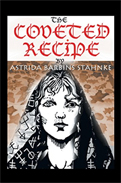
 |
Young Mara Liebman spends most of her life as a refugee. If she isn't running from her status as the bastard child of a German baron, she's trying to escape the misconception that follows her everywhere she goes. This misconception is that with her knowledge of healing herbs and her matchless talent for baking irresistible sweets that no one can replicate, she must be a witch. In Mara's seventeenth-century culture, perceived witches are prime targets for ostracism, torture, and execution by burning. In the oppressed town of Fernau surrounded by a high wall, Mara seeks refuge, only to find herself forced into servitude as the head baker to the greedy and cannibalistic executioner, the Henker. The only enlightened resident of this town is Heinrich, the mayor's adolescent son, who vows to escape the Henker's tyranny someday, taking Mara with him.
Only the Henker's addiction to Mara's ginger cookies prevents him from burning her for sorcery. But as misfortunes mount in the town, and people cry out for Mara's demise, the executioner finds himself torn between his civic duty to ply his trade and the demands of his sweet tooth. A baker's skills were not enough to save Katherina—Mara's predecessor and another accused witch—from a fiery death in her own oven. Among the executioner's principal minions are his uncouth and brutal teenage son and daughter—the twins Olga and Oleg—tasked with forcing Mara to reveal her secret ginger cookie recipe before she dies. Is Mara sufficiently strong and resourceful enough to guard her secret even unto death?
Stahnke offers readers a discussion of the Renaissance witch-burning craze with a twist. In most narratives, accused witches vehemently declare their innocence, both publicly and to themselves. By contrast, Mara occasionally toys with the idea that she might be a witch, though she never says so aloud. Addiction is a prevalent theme throughout the story, as demonstrated subtly by frequent, frantic witch hysteria throughout Germany. People crave the excitement and destruction of the hunt, trial, and execution. The executioner's addiction to Mara's cookies is a more obvious example. Refreshingly, Mara never discovers any "need" for a man in her life, as so often happens in books whose main character is a woman or girl.
Fans of the novel Weave a Web of Witchcraft by Jean Marie Robert, which centers on the Salem Witch Trials, may enjoy this book as it features a similarly strong female lead, though she is half of a married couple. A copy of Grimm's Fairy Tales containing prints of the original 1812 illustrations may provide readers with context, as the author refers to some of those illustrations late in the story. This book depicts the victimization and subjugation of women in the name of religion and other social conventions. Envious, poorer neighbors persecuted some alleged witches for their relative wealth. Mara is mistreated because of her beauty and culinary talent, as well as her illegitimacy. Audiences looking for a strong, independent female protagonist will find it in Mara. Therefore, this novella may make a fitting addition to the reading list for certain college-level women's studies courses.